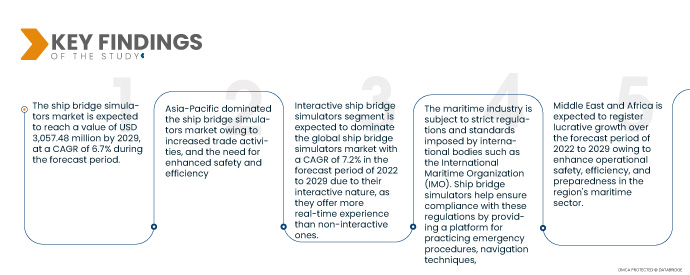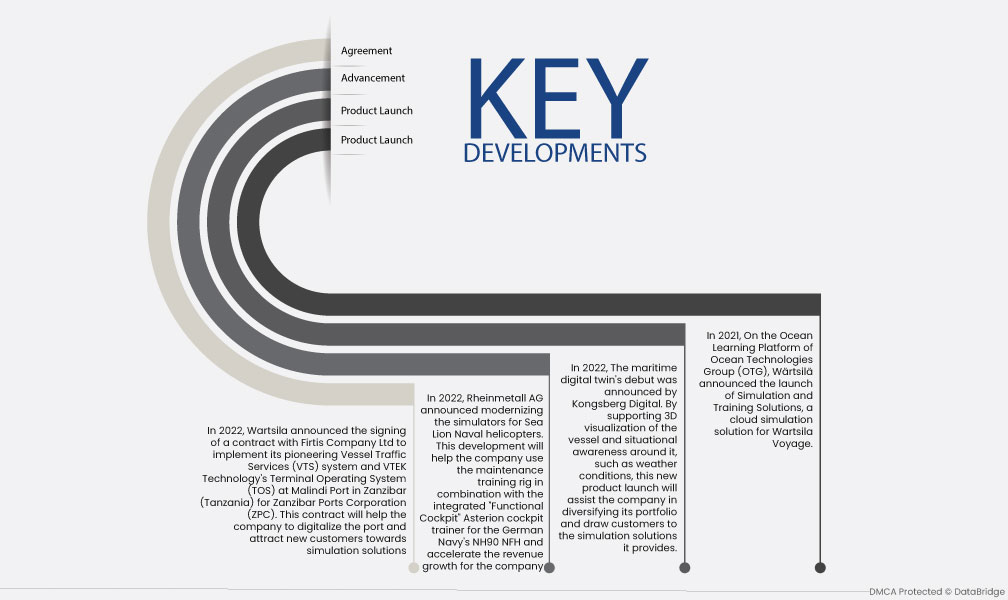Simulators are used in many aspects of the maritime industry, such as offshore operation training on ships and oil rigs, cargo handling, crane operations, towing and anchor handling, and engine control. Marine simulators are used for ship-to-shore training, vessel traffic services, and training for crane operations (VTS), in addition to the uses listed above. The growing demand for trained operators or watch officers on a ship for map-plotting, navigation, fire control, weather monitoring, surveillance, search, and mission rehearsal is anticipated to drive the global market for ship bridge simulators over the course of the forecast period.
Access Full Report @ https://www.databridgemarketresearch.com/reports/global-ship-bridge-simulators-market
Data Bridge Market Research analyses that the Ship Bridge Simulators Market is expected to reach a value of USD 3,057.48 million by 2029, at a CAGR of 6.7% during the forecast period. Ship bridge simulators are widely used for training purposes, allowing maritime personnel to gain experience and improve their skills in a safe and controlled environment. The emphasis on training and safety in the maritime industry is a significant driver for the adoption of ship bridge simulators.
Adoption of e-navigation systems is expected to drive the market's growth rate
The increasing adoption of e-navigation systems in the maritime industry has created a need for mariners to be trained in effectively operating and navigating using these advanced electronic systems. Ship bridge simulators provide a controlled environment for mariners to practice using electronic navigational charts, weather data, and other navigational information, enabling them to develop the necessary skills and competency. This demand for training on e-navigation systems has consequently contributed to the growth of the ship bridge simulator market.
Report Scope and Market Segmentation
|
Report Metric
|
Details
|
|
Forecast Period
|
2022 to 2029
|
|
Base Year
|
2021
|
|
Historic Years
|
2020 (Customizable to 2014-2019)
|
|
Quantitative Units
|
Revenue in USD Million, Volumes in Units, Pricing in USD
|
|
Segments Covered
|
Solution Type (Live Training, Professional Training, Constructive Training, Virtual Training, System Training, and Game Simulation Training), Type (Interactive Ship Bridge Simulators and Non-Interactive Ship Bridge Simulators), Organization Size (Large Scale Organizations, Medium Scale Organizations, and Small Scale Organizations), End-Use (Marine and Educational)
|
|
Countries Covered
|
U.S., Canada and Mexico in North America, Germany, France, U.K., Netherlands, Switzerland, Belgium, Russia, Italy, Spain, Turkey, Rest of Europe in Europe, China, Japan, India, South Korea, Singapore, Malaysia, Australia, Thailand, Indonesia, Philippines, Rest of Asia-Pacific (APAC) in the Asia-Pacific (APAC), Saudi Arabia, U.A.E, South Africa, Egypt, Israel, Rest of Middle East and Africa (MEA) as a part of Middle East and Africa (MEA), Brazil, Argentina and Rest of South America as part of South America.
|
|
Market Players Covered
|
Wärtsilä (Finland), Rheinmetall AG (Germany), General Dynamics Information Technology, Inc. (a subsidiary of General Dynamics, (U.S.), AVEVA Group plc (U.K.), Presagis Canada Inc. (Canada), ST Engineering (Singapore), BMT Group Ltd (U.K.), ARI Simulation (India), PC Maritime (U.K.), FORCE TECHNOLOGY (Denmark), Synergy Group (Singapore), Aboa Mare (Finland), Virtual Marine, Inc. (Canada), Simwave B.V. (Netherlands), Image Soft (South Korea), Pivot Maritime International (U.S.), VSTEP BV (Netherlands), AMC Search Ltd. (Australia), Kongsberg Digital (a subsidiary of Kongsberg Gruppen, Norway), SSPA (Sweden), American Nautical Services (U.S.), JAPAN MARINE SCIENCE INC. (Japan) among others
|
|
Data Points Covered in the Report
|
In addition to the market insights such as market value, growth rate, market segments, geographical coverage, market players, and market scenario, the market report curated by the Data Bridge Market Research team includes in-depth expert analysis, import/export analysis, pricing analysis, production consumption analysis, and pestle analysis.
|
Segment Analysis:
The ship bridge simulators market is segmented on the basis of solution type, type, organization size, and end-use.
- On the basis of solution type, the global ship bridge simulators market is segmented into live training, professional training, constructive training, virtual training, system training, and game simulation training. Live training segment is expected to dominate the global ship bridge simulators market with a CAGR of 6.9% in the forecast period of 2022 to 2029 due to its provided in depth hands on experience, which is a more effective type of training
In 2022, the live training segment is expected to dominate the solution type of the global ship bridge simulators market
In 2022, the live training segment is expected to dominate the global ship bridge simulators market owing to it provides in depth hands on experience, which is a more effective type of training and through strong presence due to their effectiveness, cost-efficiency, and ability to simulate various scenarios for training maritime professionals with a CAGR of 6.9% in the forecast period of 2022 to 2029
- On the basis of type, the global ship bridge simulators market is segmented into interactive ship bridge simulators, and non-interactive ship bridge simulators. Interactive ship bridge simulators segment is expected to dominate the global ship bridge simulators market with a CAGR of 7.2% in the forecast period of 2022 to 2029 due to their interactive nature, as they offer more real-time experience than non-interactive ones.
- On the basis of organization size, the global ship bridge simulators market is segmented into large scale organizations, medium scale organizations, and small scale organizations. Large scale organizations segment is expected to dominate the global ship bridge simulators market with a CAGR of 6.1% in the forecast period of 2022 to 2029 due to their higher capacity to invest in and maintain the equipment.
In 2022, the large scale organizations segment is expected to dominate the global ship bridge simulators market
In 2022, the large scale organizations segment is expected to dominate the global ship bridge simulators market owing to their higher capacity to invest in and maintain the equipment and through their higher operational needs, larger fleets, and greater resources compared to medium and small-scale organizations with a CAGR of 6.1% in the forecast period of 2022 to 2029.
- On the basis of end-use, the global ship bridge simulators market is segmented into marine, and educational. Marine segment is expected to dominate the global ship bridge simulators market with a CAGR of 6.4% in the forecast period of 2022 to 2029 due to the increasing usage of the simulator for training purposes
Major Players
Data Bridge Market Research recognizes the following companies as the major ship bridge simulators market players in ship bridge simulators market are Wärtsilä (Finland), Rheinmetall AG (Germany), General Dynamics Information Technology, Inc. (a subsidiary of General Dynamics, (U.S.), AVEVA Group plc (U.K.), Presagis Canada Inc. (Canada), ST Engineering (Singapore), BMT Group Ltd (U.K.), ARI Simulation (India), PC Maritime (U.K.), FORCE TECHNOLOGY (Denmark)
Market Development
- In 2022, Wartsila announced the signing of a contract with Firtis Company Ltd to implement its pioneering Vessel Traffic Services (VTS) system and VTEK Technology's Terminal Operating System (TOS) at Malindi Port in Zanzibar (Tanzania) for Zanzibar Ports Corporation (ZPC). This contract will help the company to digitalize the port and attract new customers towards simulation solutions
- In 2022, Rheinmetall AG announced modernizing the simulators for Sea Lion Naval helicopters. This development will help the company use the maintenance training rig in combination with the integrated "Functional Cockpit" Asterion cockpit trainer for the German Navy's NH90 NFH and accelerate the revenue growth for the company
- In 2022, The maritime digital twin's debut was announced by Kongsberg Digital. By supporting 3D visualization of the vessel and situational awareness around it, such as weather conditions, this new product launch will assist the company in diversifying its portfolio and draw customers to the simulation solutions it provides.
- In 2021, On the Ocean Learning Platform of Ocean Technologies Group (OTG), Wärtsilä announced the launch of Simulation and Training Solutions, a cloud simulation solution for Wartsila Voyage.
Regional Analysis
Geographically, the countries covered in the ship bridge simulators market report are U.S., Canada and Mexico in North America, Germany, France, U.K., Netherlands, Switzerland, Belgium, Russia, Italy, Spain, Turkey, Rest of Europe in Europe, China, Japan, India, South Korea, Singapore, Malaysia, Australia, Thailand, Indonesia, Philippines, Rest of Asia-Pacific (APAC) in the Asia-Pacific (APAC), Saudi Arabia, U.A.E, South Africa, Egypt, Israel, Rest of Middle East and Africa (MEA) as a part of Middle East and Africa (MEA), Brazil, Argentina and Rest of South America as part of South America.
As per Data Bridge Market Research analysis:
Asia-Pacific is expected to dominate the region in ship bridge simulators market during the forecast period 2022 - 2029
The Asia-Pacific region is anticipated to dominate the global ship bridge simulators market due to the rising demand for skilled operators and watch officers on ships. These professionals require training in various critical tasks such as map-plotting, navigation, fire control, weather monitoring, surveillance, search operations, and mission rehearsals. The region's booming maritime industry, increased trade activities, and the need for enhanced safety and efficiency are driving the demand for ship bridge simulators in Asia-Pacific.
Middle East and Africa is estimated to be the fastest growing region in ship bridge simulators market the forecast period 2022 - 2029
The Middle East and Africa region is experiencing steady growth in the ship bridge simulators market due to the expanding maritime industry. The region is home to major ports, shipping hubs, and offshore activities, driving the demand for trained maritime professionals. The growth in industries such as oil and gas, logistics, and tourism further fuels the need for ship bridge simulators to enhance operational safety, efficiency, and preparedness in the region's maritime sector.
For more detailed information about the ship bridge simulators market report, click here – https://www.databridgemarketresearch.com/reports/global-ship-bridge-simulators-market












